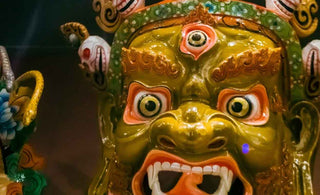
The intersection of form and function in Tibetan antique statues extends beyond the realms of aesthetic appreciation, delving into the practical and ritualistic dimensions that weave these sacred artifacts into the fabric of modern life. In contemporary society, these statues serve not merely as relics of a bygone era but as conduits for spiritual connection, grounding the ancient in the present.
On a practical level, Tibetan antique statues often find themselves seamlessly integrated into modern living spaces as exquisite pieces of interior decor. The intricate craftsmanship and timeless beauty of these statues make them not only art objects but also statements of cultural reverence. Whether adorning homes, offices, or cultural institutions, these statues become silent narrators of Tibetan heritage, sparking curiosity and dialogue about the rich tapestry of spiritual wisdom they encapsulate.
The ritualistic uses of Tibetan antique statues, however, unfurl in a more profound and deeply personal manner. In a world characterized by hustle and bustle, these statues provide individuals with tangible focal points for contemplation and introspection. Many people incorporate these statues into their personal meditation spaces, using the serene countenance of the Buddha or the dynamic postures of bodhisattvas as aids in their spiritual practices. The statues become not only visual anchors but also conduits for channeling inner serenity in the midst of life's chaos.
Consider a contemporary urban dweller, surrounded by the demands of a fast-paced life.Its form, a testament to the artistic mastery of Tibetan craftsmen, introduces an element of timeless beauty into the living space. Positioned strategically within the home, its serene countenance and intricate details create an oasis of tranquility, a visual balm that contrasts with the hustle and bustle of the surrounding cityscape. The statue becomes more than a mere artifact; it transforms into a conversation piece, sparking curiosity and dialogue about the rich cultural and spiritual heritage it represents.
Simultaneously, the statue transcends its role as a decorative object and steps into the realm of ritualistic function. As the individual seeks solace amid the demands of daily life, the statue serves as a focal point for moments of mindfulness and prayer. Picture the urban dweller, taking intentional pauses in their day, drawn to the statue in moments of quiet reflection. Before the Bodhisattva of Compassion, they find a space to ground themselves, to connect with a deeper sense of purpose, and to tap into the wellspring of compassion that Avalokiteshvara symbolizes.
During these ritualistic interludes, the individual may engage in meditation or offer prayers, using the statue as a tangible conduit to the divine. The act of lighting incense becomes a bridge between the tangible and the metaphysical, with fragrant tendrils rising in graceful homage. The statue becomes not only an anchor for spiritual practices but a portal to inner peace, a tangible representation of the sacred within the confines of the contemporary living space.
Consider the exquisite details of the Avalokiteshvara statue—an embodiment of compassion with multiple arms gracefully poised in dynamic mudras. Each arm, a symbol of swift and skillful response to the cries of suffering, resonates with the urban dweller navigating the complexities of modern existence. The eyes of Avalokiteshvara, gazing with serene compassion, reflect the yearnings and challenges of the individual seeking solace. The ritualistic engagement with the statue, in this context, becomes a dialogue—a silent exchange between the individual and the embodiment of compassion.
Here, form and function harmonize, offering a sanctuary where the ancient wisdom encapsulated in the statue intersects with the lived experiences of the modern practitioner.
The ritualistic use of Tibetan antique statues further extends into ceremonies and gatherings where communities come together to celebrate shared spiritual values. These statues become focal points during religious ceremonies, serving as embodiments of divine presence and guiding participants on their collective journey towards enlightenment. In this communal context, the statues not only bridge the gap between the past and the present but also unite individuals in a shared spiritual experience.
In essence, the form and function of Tibetan antique statues in modern life embody a delicate dance between the tangible and the metaphysical. As aesthetic marvels, they contribute to the visual tapestry of contemporary spaces, inviting onlookers to appreciate the enduring beauty of Tibetan craftsmanship. Simultaneously, as vessels of spiritual wisdom, they provide individuals with tangible tools for cultivating mindfulness, compassion, and a connection to the sacred. The synthesis of these dimensions ensures that Tibetan antique statues continue to be revered not as relics of a bygone era but as living artifacts that enrich the spiritual landscape of the present.























